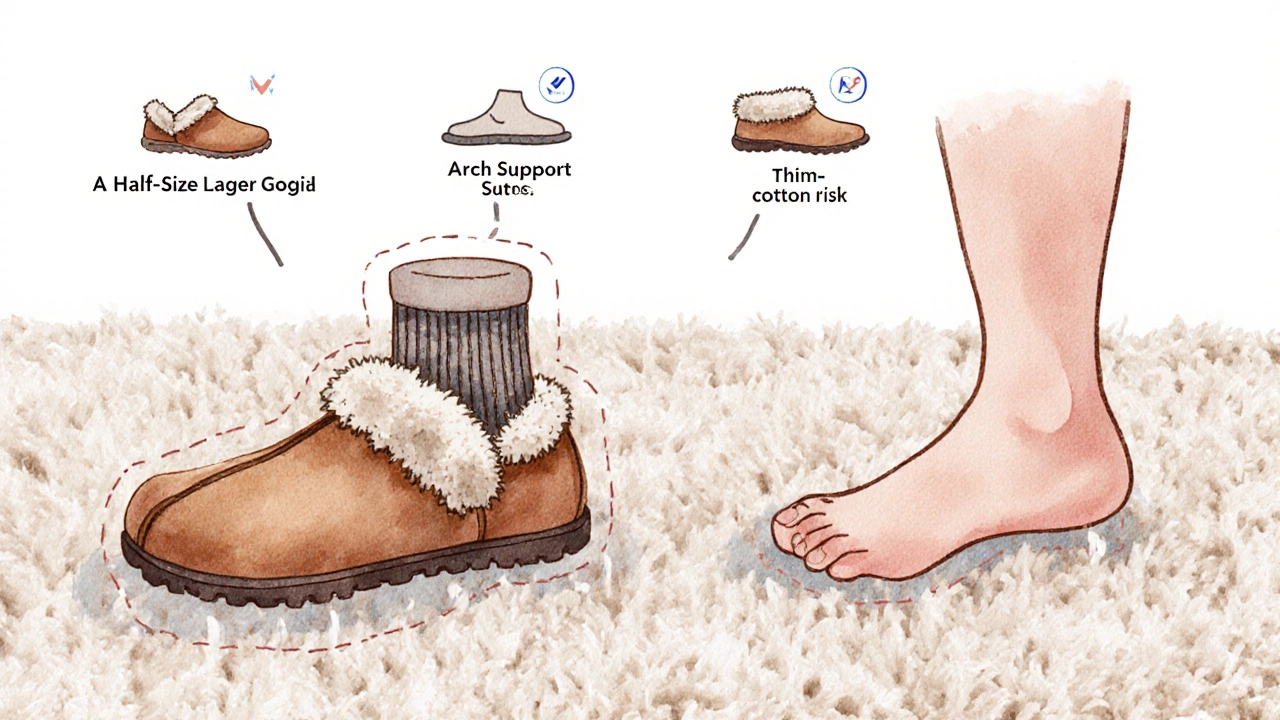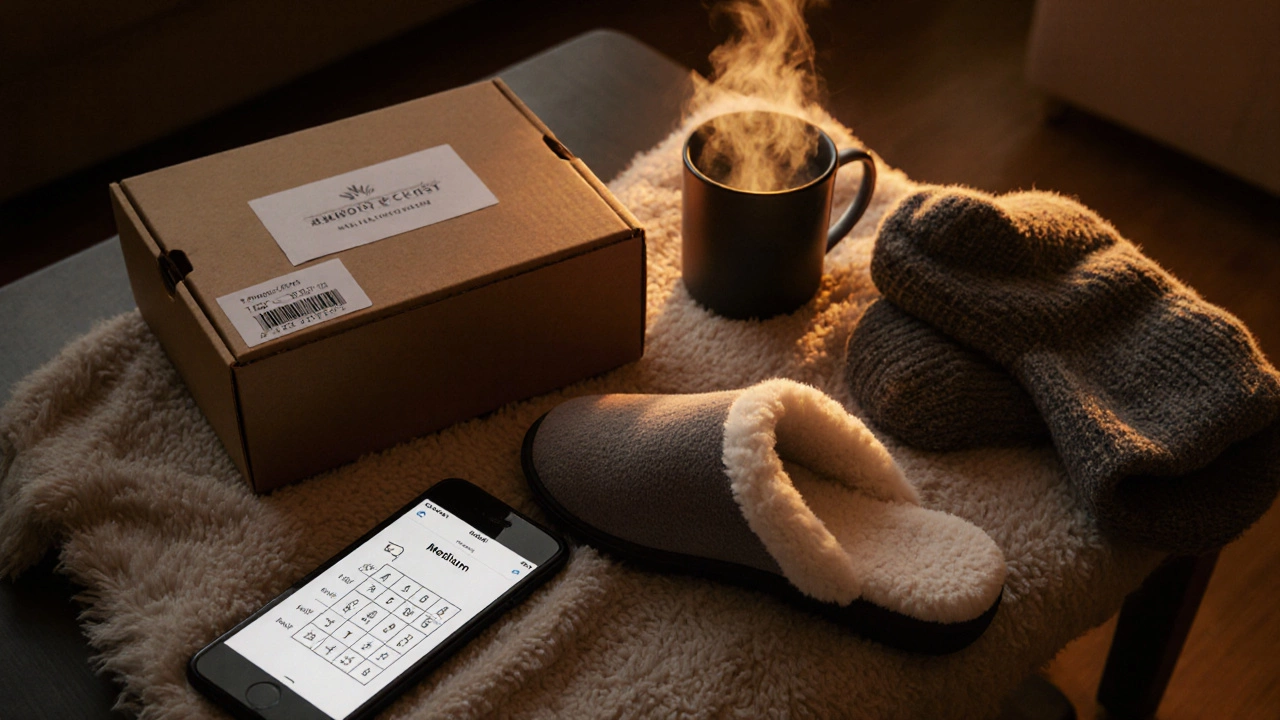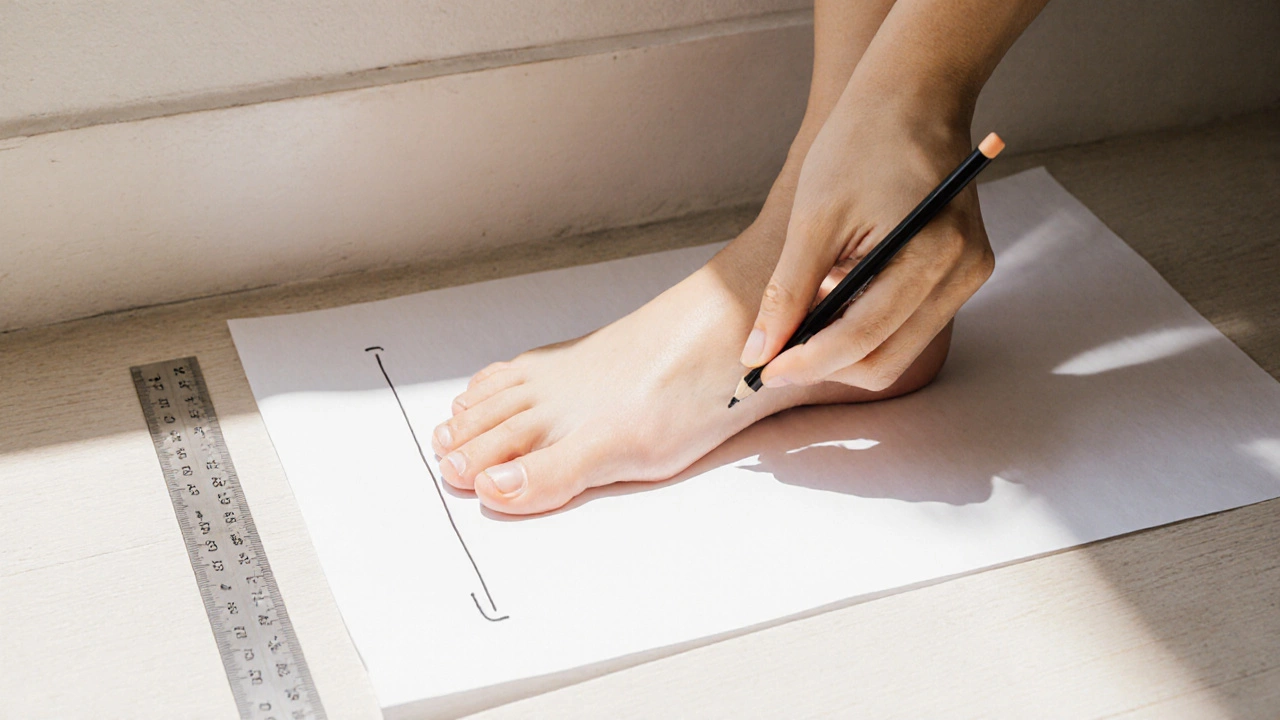Slipper Size Calculator
Find Your Perfect Slipper Size
Recommended Size
Finding the perfect fit for indoor footwear can be surprisingly tricky, especially when you’re staring at two identical pairs-one labeled a half size up and the other half down. This slipper size guide strips away the guesswork and walks you through the exact steps to decide whether a bigger or smaller pair will keep your feet happy.
Why Slipper Fit Matters Differently Than Shoes
Unlike structured shoes, slippers are designed to be lightweight, flexible, and often lack the rigid toe box that keeps a shoe snug. Their soles are usually thinner, and the upper material-whether plush fleece, soft leather, or memory foam-conforms to your foot over time. Because of that, a slipper that feels a bit loose at first can settle into a perfect hug, while one that’s too tight may never give.
Key factors that set slipper fit apart:
- Material flexibility - foam and knit uppers stretch more than suede.
- Lack of laces or straps - there’s less mechanical tension to hold the foot in place.
- Indoor use - you’re often wearing socks, which adds a layer of padding.
Step‑by‑Step: How to Measure Your Foot Accurately
Before you even think about sizing up or down, get a reliable foot measurement. Follow these simple steps:
- Place a blank sheet of paper on a hard floor and ankle against a wall.
- Stand straight; your weight should be evenly distributed.
- Mark the longest tip of your toe and the back of your heel where they meet the paper.
- Use a ruler to measure the distance between the two marks. Record the result in centimeters.
For the most accurate reading, measure both feet and use the larger measurement. This process is called foot measurement, and it gives you a solid baseline before you compare it to any slipper’s size chart.

Shoe Size vs. Slipper Size: Bridging the Gap
Most brands list slipper sizes using the same numeric system as shoes, but the conversion isn’t always one‑to‑one. A shoe size 9 in US men’s sizing may correspond to a slipper that feels like a size 9½ because of the extra room built into the sole.
Here’s how to interpret the numbers:
- Shoe size - the official measurement used for outdoor footwear, typically based on foot length plus a tolerance factor.
- Slipper size - a nominal label that may be tighter or looser depending on the brand’s design philosophy.
When a brand provides a size chart, cross‑reference your foot measurement with the chart, not just your regular shoe size. If the chart suggests you’re between two sizes, that’s where the bigger‑or‑smaller decision comes in.
Size Bigger vs. Size Smaller: Pros and Cons
To make the choice clear, compare the two options across the most common concerns.
| Aspect | One Size Bigger | One Size Smaller |
|---|---|---|
| Immediate Comfort | Often feels loose at first; may need a few minutes to settle. | Snug right away; can feel constricting on wider feet. |
| Long‑Term Fit | Material stretches, creating a custom fit over time. | Less stretch; may lead to pressure points. |
| Arch Support | More room for orthotic inserts if needed. | Limited space for added support. |
| Return Risk | Higher chance of keeping if you prefer a relaxed feel. | Higher chance of returning due to tightness. |
| Suitability for Socks | Plenty of room for thick or wool socks. | May feel cramped with bulkier socks. |
In practice, most people find that a slightly larger slipper delivers better long‑term comfort, especially with flexible materials like memory foam. However, if you have a narrow foot or need extra arch support, the smaller size might stay secure.
Special Considerations Before You Choose
Beyond the simple bigger‑or‑smaller debate, a handful of personal factors can tip the scales.
- Foot swelling - feet tend to expand by up to 10% after a long day. If you often experience swelling, err on the larger side.
- Sock thickness - heavy winter socks require extra room, while light cotton socks work fine in a tighter fit.
- Arch support needs - orthotic inserts add about 0.5cm to the foot’s height; allow space accordingly.
- Material - suede and leather take longer to break in; foam molds quickly, so a smaller size may become comfortable faster with foam.
Answering these quick questions for yourself helps you land on the right size without endless returns.

Return Policy & Trial Tips
Even with perfect measurements, a brand’s return policy can save you from a bad fit. Look for these features:
- Free return shipping within 30days.
- Ability to try slippers on at home for at least 24hours.
- No restocking fee for size exchanges.
When you receive the slippers, wear them around the house for a full evening. Walk on different surfaces-carpet, tile, hardwood-to see how the sole grasps and how the upper reacts. If the feeling stays loose after a few hours, upgrade to a smaller size; if it feels tight, size up.
Quick Cheat‑Sheet Checklist
- Measure both feet; use the larger length.
- Check the brand’s size chart; note any “+0.5” recommendations.
- If you’re between sizes, list your priorities (comfort vs. snugness).
- Consider foot swelling, sock thickness, and orthotic use.
- Buy from a retailer with a flexible return policy.
Follow this list and you’ll walk away with slippers that feel right from the first step.
Frequently Asked Questions
Do slippers run true to size?
Most casual brands design slippers a touch smaller than a shoe because the material stretches. Check the specific brand’s chart and plan for a half‑size up if you’re unsure.
Can I wear slippers with thick winter socks?
Yes, but you’ll likely need to size up a half or full size depending on the slipper’s material. Foam and knit uppers accommodate bulkier socks better than leather.
What if my feet swell in the evening?
Foot swelling can add up to 0.5cm in length. If you notice this regularly, choose the larger size or a brand that offers a looser fit.
Should I buy slippers online without trying them first?
Online shopping is fine as long as the retailer provides a clear size chart and a hassle‑free return policy. Use the measurement steps above to emulate a try‑on experience.
Do I need arch support in slippers?
If you have flat feet or experience arch pain, look for slippers with built‑in arch cushions or plan to insert a thin orthotic. Make sure the size you choose leaves enough room for the insert.

